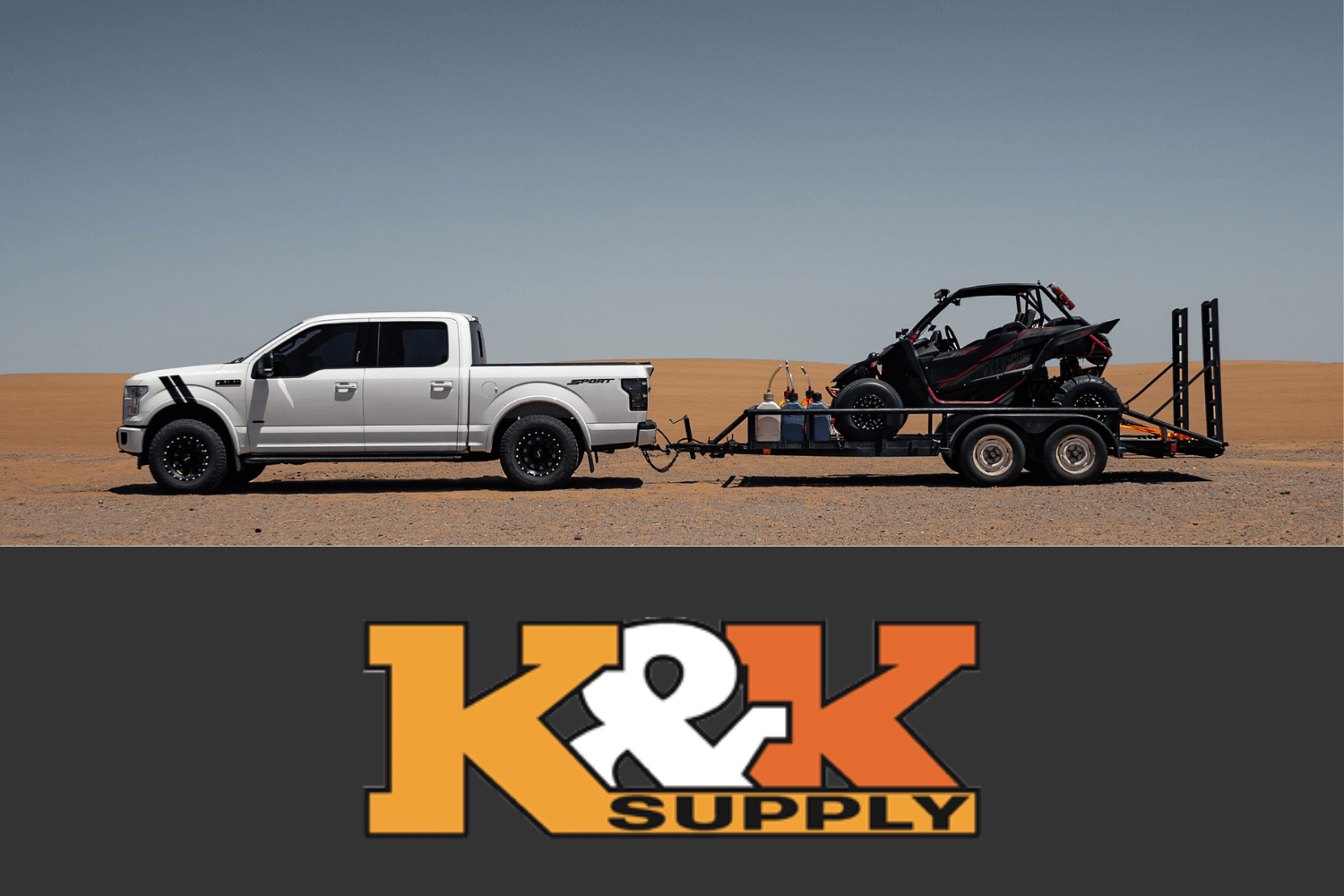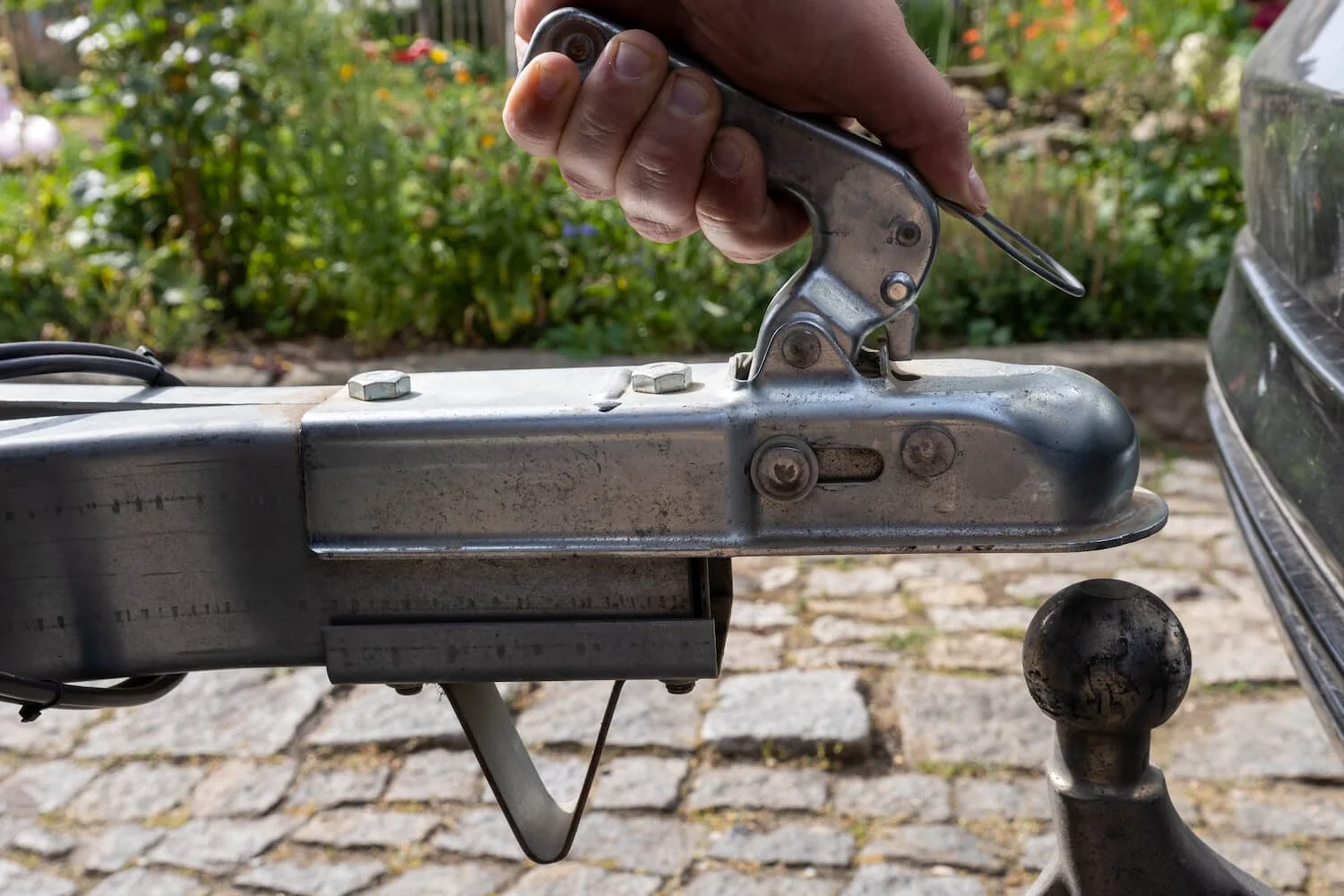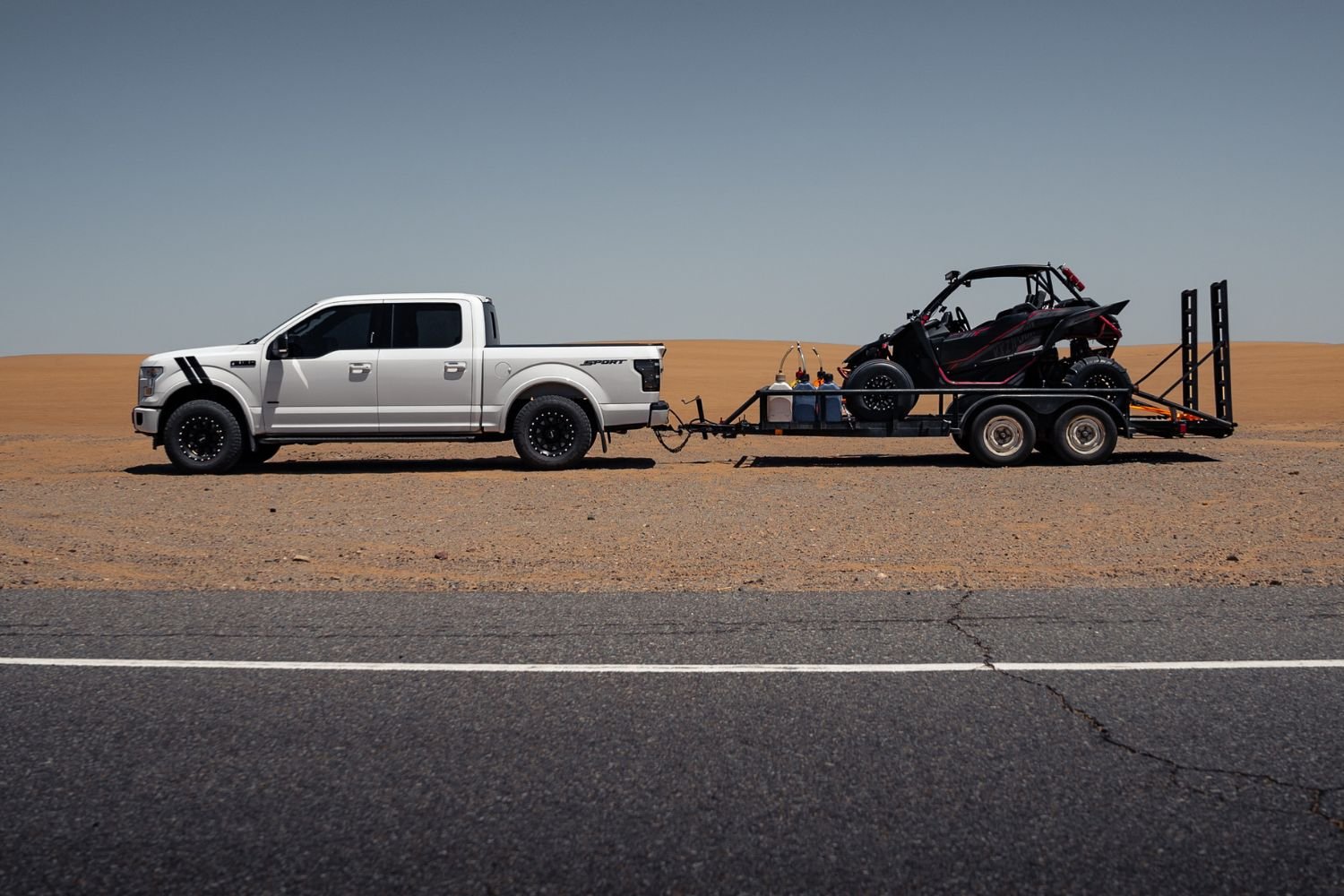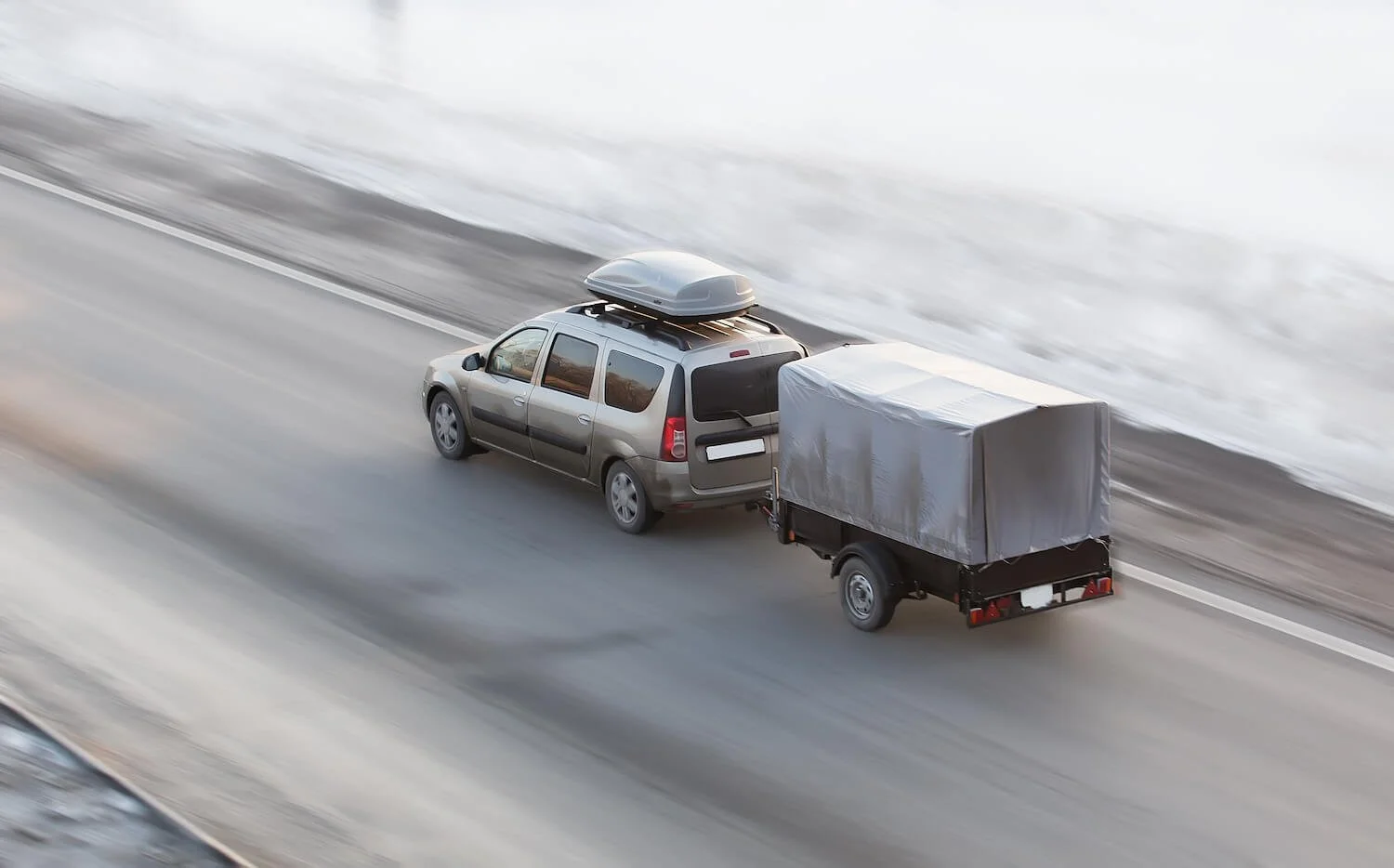The Ultimate Guide To Towing Trailers
(A 5-Step Action Plan for Expert Towing)
Taking a road trip feels like freedom. The wide-open road of endless possibilities.
Bringing your trailer packed with speedboats, UTVs, or other fun-in-the-sun toys adds an element of adventure to your trip.
But incorrectly towing trailers, thus delaying and disrupting your trip, is dangerous and disastrous.
No thank you.
Avoid common mishaps when towing trailers by following K&K Supply's Ultimate Guide To Towing Trailers.
In this guide, you'll get a clear action plan to safely hitch and tow your trailer like a pro and be on the road in no time.
Let's get to it.
Key Findings:
Towing trailers, and the items you want to take with you, can make your vacations more enjoyable. Yet it's essential to have the right tools and equipment and prep your vehicles correctly to avoid road delays.
In this Ultimate Guide, you'll:
Learn every aspect of towing to ensure a smooth ride
Get clear on the equipment needed to hitch the trailer
Learn how to properly attach the hitch connection point for the tow vehicle and trailer
Review safety vehicle checks
Take necessary measures to protect yourself on the road
After following our five-step plan, you'll be ready to ride.
(Pro tip: check out our trailers for sale and Bear Track Trailer guide if you need help picking the right trailer)
Here We Go—Buckle Up.
Step 1: Vehicle Weight Considerations
Before you drive off into the sunset, the first thing to consider is the vehicle weight limit.
You must confirm the vehicle towing capacity can handle the trailer's weight. Exceeding the weight limits can cause severe damage to your engine, suspension, and brakes and be extremely dangerous for operating on the road. Yikes!
Knowing your vehicle limits and aligning the correct weight proportions are KEY for a successful tow.
First things first:
Opt for rear-wheel drive for optimal towing capacity. In normal driving conditions, four-wheel drive can ruin your towing power and damage your vehicle.
Consider a truck or SUV with a longer wheelbase for more vehicle control.
Tune into torque: Torque is a measurement of your car's ability to do work. AKA, the more torque, the more power an engine can produce. (KIA) So trucks with a higher tow rating usually have diesel engines.
NUMBERS TO KNOW
Tow Rating:
The maximum weight you can pull with a vehicle
Note: Listed tow rating does not include passengers and cargo. Make sure you have the actual weight in your truck, so you're not unpleasantly surprised
Gross Vehicle Weight Rating (GVWR):
How much your truck can carry inside it — the driver, passengers, and cargo
You can find this on the plate affixed to the sidewall or check the owner's manual
Gross Combined Weight Rating (GCWR):
The total weight of your loaded truck and trailer
Find this by adding the gross vehicle weight (GVW) with the gross trailer weight (GTW) / loaded trailer weight
Vehicle Curb Weight:
How much the vehicle weighs when empty, including gas and fluids
This is the weight without cargo or passengers
You need this to calculate the CVWR (see below)
Trailer Tongue Weight:
How much weight the towed load exerts on the truck's tongue
9-15% of total trailer weight
Reminder: This tongue weight only accounts for an empty trailer
Remember to add the cargo mass in or on the trailer before calculating the tongue weight if you use the trailer for towing and hauling
HERE’S HOW IT WORKS:
Use these measurements to ensure you're within the vehicle's tow capacity.
Gross Combined Weight Rating (GCWR)
If the Gross vehicle weight + gross trailer weight + passengers/cargo is < (LESS THAN) the GCWR = Good to go! 👍
Gross Vehicle Weight Rating (GVWR)
If the gross vehicle weight + tongue weight of the trailer (usually 9-15% of gross trailer weight) is < (LESS THAN) the GVWR = Good to Go! 👍
Reminder: Manufacturers often advertise the maximum tow weight without cargo or passengers. Always calculate your weight limits to avoid damage to your vehicle or being stranded on the road.
Now that truck and trailer weights are a match made in tow heaven, what's next?
Let's review all the equipment you'll need.
Step 2. Equipment Overview
Checklist Time!
Gather these pivotal items to ensure a smooth ride.
Set-Yourself-Up-For-Success Checklist:
The Hitch (Receiver)
Ball Mount
Ball Hitch
Trailer Ball
Trailer Coupler
Pins and Clips
Hitch Lock
Wiring Harness
Safety Chains
Trailer Brake Controller
Wheel Chocks
Let's Break It Down:
The Hitch (Receiver)
Hitch is a term that means the connector of the tow vehicle and trailer. Because hitch receivers are the most common hitches, people interchange the words.
Hitches are composed of the hitch receiver, ball mount, ball, and wiring harness.
The hitch receiver is a hitch that is secured at the back of the tow vehicle and contains a tube for attaching the ball mount.
Ball Mount
A ball mount is an accessory on the receiver hitch that includes a shank and a trailer ball platform. The platform of the leg is a solid mounting point for a trailer ball.
Ball Hitch
Commonly interchanged with ball mount, this is a connector for hooking on the trailer. The main difference is that a ball hitch includes a ball mount as part of a larger mechanism.
Trailer Ball
This is the primary connecting point between the tow vehicle and the trailer, thus making it essential to the process. You must find the specific fit for your trailer.
The trailer ball allows the trailer to flow correctly, ensuring safe turns and rides over challenging terrain.
Trailer Coupler
A latch for your trailer ball to help it maneuver around yet stay connected.
Pins and Clips
Always double check your pins are in place! They keep the mount ball in place, securing the hitch and connection point.
A hitch pin is bent in an "L" shape designed to insert into the side of the hitch receiver, pass through the ball mount shank and come out the other side. Hitch pins also have a hole on the end to accept a hairpin-shaped clip. The hitch clip is made from spring steel and keeps the pin in the receiver (Source: Curt).
Hitch Lock
You don't want to lose your trailer while driving, but there's also a risk of losing it while it's parked—aka theft. Savvy travelers prevent this by using a hitch lock. This device is key-protected to ensure your trailer stays where you leave it.
Wiring Harness
An electric wire for the tow vehicle's electrical system to attach to the trailer. It's necessary because it connects various electrical systems to the trailer, including brake lights, turn signals, etc.
Safety Chain
Your best backup if the hitch ever becomes unattached. The safety chain should be strong enough to hold the trailer and tow vehicle together as one unit should they disconnect.
Trailer Brake Controller
Depending on each state, specific laws kick into effect that requires separate trailer brakes when a trailer is over a stated weight limit.
The trailer brake controller is a device that aligns with the tow vehicle's brake system to control braking from the driver's seat.
Wheel Chocks
These act as enforcers behind the tires for hilly excursions, offering extra parking support.
Helpful Add-On Options To Lighten The Work Load:
Electric Tongue Jack
Transmission Cooler
Weight Distribution System
Cold Air Intake
Transmission Temperature Gauge
Engine Programmer
Back up Camera
RV GPS
The good news is most of these items are affordable and can be purchased online or at a local automotive shop.
Once you gather the items, you're ready to ensure the hookup goes on with a hitch!
Step 3: Make Sure Your Hookup Goes on With a Hitch
We mentioned hitches in our equipment guide, but here's the deal:
The hitch connection point is the most critical thing you'll do to secure your trailer to your tow vehicle.
So let's get this right!
Finding the correct hitch depends on the vehicle and your trailer. To get started, you'll need to know:
What size hitch receiver you have
What size ball you need
When you have the correct hitch, place it into the receiver and secure it with the pins and clips. Some hitches are adjustable, so hook yours up at the proper height to match your trailer.
Hitching Your Trailer:
Back It Up: Back your vehicle up slowly towards the hitch. A backup camera is ideal for this purpose.
Alignment: Make sure the hitch ball sits directly under the ball housing.
Crank The Jack: Once the hitch ball lines up, put the tow vehicle in park and lower the trailer onto the truck by cranking the jack. Ideally, they should fit like a glove. Keep cranking until the weight is entirely off the jack foot.
Lock It Up: Once the hitch is attached, close the hitch ball lock to secure it.
Extra Extra: Put those pins in place for added tightness.Store Jack Foot: Once your hitch is locked and loaded, store your jack foot. This method varies depending on the product, so consult the user's manual.
Safety Chains: You're so close, but don't forget those safety chains! Remember, these will be your lifeline should your hitch lose connection.
#1 Rule of safety chains - ALWAYS CROSS THEM
For example, Point A -> B and B -> AFinally, Light It Up: Remember that wiring harness? Use it here. Most outlets only have one way it can fit correctly, so intuitively match the wire to the outlet.
Reminder: Weight balance on the trailer is extremely important. Double-check Step 1 to ensure your weight is good to go.
Generally, you're looking for the tow vehicle and trailer to balance evenly on the ground.
Whew, we completed the hard work! Feeling ready to rock-n-roll? Let's load it up!
(Source: Auto Guide)
Step 4: How to Load Your Trailer
Since you're well on your way to becoming an expert tower, you know that weight is an essential factor in a safe pull. The weight distribution of your cargo is equally as important for towing trailers.
An imbalance of weight can lead to dangerous trailer reactions on the highway.
In this video, demonstrated by the Ontario Police Commercial Vehicle Committee, you'll see that too much weight at the rear of the trailer can cause the trailer to fishtail. Excessive weight at the front can cause ineffective brakes because the vehicle sags.
Goal: Achieve an even distribution of cargo.
To keep this even weight distribution, pack the trailer properly. Here are a few steps for success:
Pack your trailer so your tongue weight is 9-15% of the gross trailer weight. Too much tongue weight will pull your rear suspension down.
Aim for 60% of load weight in the front half.
Evenly distribute weight on the right and left sides of the trailer. Don't pick favorites and topple over on a tight turn.
Prevent cargo from shifting by securing it with tie-downs or ratchet straps.
We're feeling snug and secure. It's time to take the show on the road, but first, you have one more checkpoint to get through.
(Source: GMC)
Step 5: Final Vehicle Checks and Road Safety
We love being thorough because guess what? It's much easier and less stressful to fix problems BEFORE cruising down the highway with other automobiles and passengers flying by you.
So the final step before hitting the road is the buffer step—your last chance to catch anything you overlooked.
To make it super simple for you (because we like simple!), here's a quick list to ensure you're ready to ride.
1. Complete a final check around your entire vehicle and trailer. Go over every step one last time. We promise it takes less time than you think.
Check that hitch one more time. Is it secure? Are the pins in place? Tug the security chain to ensure it's properly fastened.
2. Check Your Tires: Inflate tires fully. The owner's manual may give you the exact pressure required for towing. Underinflated tires can cause resistance, thus increasing pressure on the engine. If tires are not top-notch, this could cause significant problems or a blowout.
Some people forget the trailer tires. If the trailer sits for a while, it can lead to dry rot or cracking. Check it!
Don't get stuck on the side of the road. Always have spare tires and, you guessed it, double-check that they are in working condition. Make sure to have the proper tools for changing a tire, including a jack.
3. Light and Bright: A trailer's lights are equally as crucial as the tow vehicle's lights—don't skip this step! Accidents can occur at night if the trailer lights are broken or disconnected. Ensure these lights are working before taking off:
Running Lights
Brake Lights
Turn Signals
Hazard Lights
4. Mirror Mirror: Your vehicle mirrors should extend out far enough to allow a vision of the back end of your trailer and beyond. Legally, you have to be able to see the car directly behind you while towing. If sight is blocked, it's time to invest in extendable tow mirrors.
Tow mirrors attach to your vehicle and give a broader view so that you can check your surroundings. Some even come with blind-spot detectors.
5. Brakes That Work: Like in everyday situations, brakes should be new and in working condition. Check the brakes on your vehicle and trailer regularly to ensure they are working.
Did You Know? Most states have a law requiring trailer brakes if they are over the Gross Trailer Weight. Review the regulations for your local laws and travel destination.
It's time to drive! But do you know how to drive your vehicle when a trailer is attached?
Wait…What?
That's right; there are driving differences to learn when you're lugging a load. But we'll line them for you!
Key Driving Differences:
The first thing to understand is that you need to slow down your speed when pulling a heavier weight—and that's okay! You should absolutely prioritize safety over speed.
Speed control also applies to braking. Because of the added weight, braking will take longer. Leave more distance between the car in front of you.
When approaching a corner or turn, always err on the side of turning wider than normal.
Plan your route in advance to avoid pesky delays or tight spaces such as closed lanes due to construction, road bumps, or uneven ground.
If your trailer starts to fishtail, reduce acceleration but don't hit the brakes.
Stay in the right lane of the road. If you need to switch lanes, give yourself extra time.
There you have it—five steps to safely, efficiently, and correctly tow trailers.
Now that you're an all-around expert in towing, we're sure you have miles of road to explore.
The final question: Where to travel next?!






